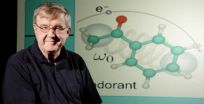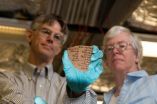(Press-News.org) CHAMPAIGN, Ill. — A new study of the sense of smell lends support to a controversial theory of olfaction: Our noses can distinguish both the shape and the vibrational characteristics of odorant molecules.
The study, in the journal Physical Chemistry Chemical Physics, demonstrates the feasibility of the theory – first proposed decades ago – that the vibration of an odorant molecule's chemical bonds – the wagging, stretching and rocking of the links between atoms – contributes to our ability to distinguish one smelly thing from another.
"The theory goes that when the right odorant binds to its receptor, the odorant's molecular vibration allows electrons to transfer from one part of the receptor to another," said University of Illinois physics professor Klaus Schulten, who conducted the analysis with postdoctoral researcher Ilia Solov'yov and graduate student Po-Yao Chang. "This electron transfer appears to fine-tune the signal the receptor receives."
(Watch a video about the research.)
Many who study olfaction maintain that odorant receptors recognize only an odorant's shape and surface characteristics. They dismiss the idea that molecular vibration has anything to do with it, Schulten said. Likewise, some proponents of the vibrational theory think that molecular vibration only, and not shape, guides the sense of smell. Schulten and his colleagues belong to a "third camp" that sees evidence for both, he said.
The vibrational theory of olfaction is supported by studies showing that insects, humans and other animals can tell the difference between two versions of the same odorant molecule – a normal one and an identical one with deuterium atoms substituted for each of the hydrogens. The deuterated and normal versions of the odorant have the same shape and surface characteristics, and yet humans and other animals can smell the difference, Schulten said.
"The question then is of course, for scientists, how does this happen?" he said.
To answer this question, Schulten turned to the work of a former colleague at Illinois, Rudolph Marcus, a chemist (now at Caltech) who received the Nobel Prize in Chemistry in 1992 for his insights into electron transfer, one of the most basic forms of a chemical reaction.
"Marcus realized that when electrons are being exchanged between molecules the process is coupled to the vibrations of the molecules involved," Schulten said. Marcus focused primarily on the low-frequency "rumblings" that occur as a result of molecular vibration in large molecules, Schulten said.
Odorant molecules are generally quite small, however, with a lot of high-frequency, high-energy vibrations, Schulten said. Some scientists have theorized that these high-frequency vibrations can, when an odorant binds to the right receptor, enhance the likelihood that an electron will transfer from one part of the receptor to another, sending an electrical signal that contributes to the detection of that odor.
Prior to the new study, no one had analyzed the energetics of the system to see if the vibrations of the odorant molecules – in the context of all the background vibrations that are part of the system – could actually promote electron transfer within the receptor. Schulten and his colleagues are the first to conduct such an analysis, he said.
"You can actually carry out quantum chemical calculations that determine very precisely the vibration of the molecule as well as the ability to couple it to electron transfer," Schulten said. The calculations indicate that such an interaction is energetically feasible, he said.
Odorant receptors are embedded in membranes and so are more difficult to study than other proteins. But previous research indicates that some receptors are metalloproteins, and "the metals in the proteins are pre-designed to transfer electrons," Schulten said. "We also see that there are other amino acid side groups that can accept an electron, so the electron can be transferred through the protein."
Like others before them, Schulten and his colleagues suggest that the odorant receptor contains both an electron donor and an electron acceptor, but that electron transfer occurs only when a specific odorant is bound to the receptor. The new calculations offer the first quantitative evidence that the odorant can in fact promote electron transfer.
Those who suggested that molecular vibration played a role in odorant recognition in previous studies "didn't know about Marcus' theory and they didn't do quantum chemical calculations," Schulten said. "They argued very much on principle (that it was possible). So we are saying now, yes, it is really possible even when you do the most complete and reliable calculations."
INFORMATION:
Editor's notes: To reach Klaus Schulten, call 217-244-1604; email schulten@illinois.edu.
The paper, "Vibrationally Assisted Electron Transfer Mechanism of Olfaction: Myth or Reality," is available online or from the U. of I. News Bureau.
Odorant shape and vibration likely lead to olfaction satisfaction
2012-09-19
ELSE PRESS RELEASES FROM THIS DATE:
New airport system facilitates smoother take-offs and landings
2012-09-19
Contact: David Hosansky
303-497-8611
hosansky@ucar.edu
NCAR/UCAR
Zhenya Gallon, NCAR/UCAR Media Relations
303-497-8607
zhenya@ucar.edu
New airport system facilitates smoother take-offs and landings
BOULDER--For airline passengers who dread bumpy rides to mountainous destinations, help may be on the way. A new turbulence avoidance system has for the first time been approved for use at a U.S. airport and can be adapted for additional airports in rugged settings across the United States and overseas.
The system, developed by the National Center for Atmospheric ...
GEOLOGY adds 30 new articles online
2012-09-19
Boulder, Colo., USA – This month, GSA's top geoscience journal, Geology, has posted 30 new articles ahead of print. Locations studied include Bhutan; the James Bay Lowland of Canada; Mount Taranaki, New Zealand; Fort Stanton Cave and Carlsbad Cavern, New Mexico, USA; the Quelccaya Ice Cap, Peru; the Nile Delta; and Mars. Topics include methane hydrates, microbial micro-tunneling, fibrous diamonds, climate change, cosmic rays, and maars. Also in Geology: the first application of CARS microscopy to the geosciences.
Highlights are provided below. GEOLOGY articles published ...
Joint UT study: Reading food labels helps shoppers stay thinner
2012-09-19
KNOXVILLE—Shoppers — particularly women — who take the time to read food labels are thinner than those who don't.
These findings are from a recently released study authored by Steven T. Yen, a University of Tennessee professor in the Institute of Agriculture's Department of Agricultural and Resource Economics, in conjunction with researchers at the University of Santiago de Compostela in Spain, the University of Arkansas and the Norwegian Institute for Agricultural Finance Research.
Women who read food labels weighed nearly 9 pounds less than women who didn't read labels, ...
Surprising demographic shifts in endangered monkey population challenge conservation expectations
2012-09-19
MADISON – At first glance, the northern muriqui monkey is a prime conservation success story.
These Brazilian primates are critically endangered, but in the past 30 years a population on a private reserve has grown from just 60 individuals to some 300, now comprising almost a third of the total remaining animals.
As the population grows, though, it is offering researchers a glimpse into a new phase of recovery as it begins to face the limitations of its habitat. A recent analysis of the factors contributing to this population's tremendous growth reveals surprising trends ...
New tools help nursing homes track and prevent deadly infections
2012-09-19
CHICAGO (September 18, 2012) – The Society for Healthcare Epidemiology of America (SHEA) and Centers for Disease Control and Prevention (CDC) have each released new tools and information to help track deadly healthcare-associated infections (HAIs) in nursing homes and other long-term care settings. Potentially deadly HAIs strike volumes of nursing home residents each year, with best estimates suggesting that up to 2.8 million infections can occur in this population annually.
Published online this week in Infection Control and Hospital Epidemiology, the journal of SHEA, ...
Economic freedom report: US continues slide, drops to 18th
2012-09-19
TALLAHASSEE, Fla. ⎯ The United States, long considered a champion of economic freedom, plunged to No. 18 in new rankings published in the 2012 Economic Freedom of the World, an annual report co-authored by Florida State University economics Professor James Gwartney.
The report is published by Canada's Fraser Institute in cooperation with institutes in 78 other nations and territories. The U.S. publisher is the Cato Institute. The 2012 report, released on Sept. 18, uses 42 different variables derived from sources such as the World Bank and International Monetary ...
Dictionary completed on language used everyday in ancient Egypt
2012-09-19
A dictionary of thousands of words chronicling the everyday lives of people in ancient Egypt — including what taxes they paid, what they expected in a marriage and how much work they had to do for the government — has been completed by scholars at the University of Chicago.
The ancient language is Demotic Egyptian, a name given by the Greeks to denote it was the tongue of the demos, or common people. It was written as a flowing script and was used in Egypt from about 500 B.C. to 500 A.D., when the land was occupied and usually dominated by foreigners, including Persians, ...
Funding for medical research and science programs faces draconian cuts
2012-09-19
Bethesda, MD – A new report from the Office of Management and Budget (OMB) is a stark reminder of the perilous situation facing the medical research and scientific communities unless Congress and the President take action to prevent the pending sequestration. Set in motion by the Budget Control Act of 2011, sequestration would impose automatic cuts on federal funding starting on January 2, 2013. According to OMB, the budget for the National Institutes of Health (NIH) would be reduced by $2.529 billion, the National Science Foundation would lose $586 million, and the Department ...
Notre Dame research could provide new insights into tuberculosis and other diseases
2012-09-19
Researchers Patricia A. Champion and Matthew Champion from the University of Notre Dame's Eck Institute for Global Health have developed a method to directly detect bacterial protein secretion, which could provide new insights into a variety of diseases including tuberculosis.
The Champions point out that bacteria use a variety of secretion systems to transport proteins beyond their cell membrane in order to interact with their environment. For bacterial pathogens like TB these systems transport bacterial proteins that promote interaction with host cells, leading to ...
Engineering a better hip implant
2012-09-19
VIDEO:
University of Iowa researchers have determined that thigh size in obese people is a reason their hip implants are more likely to fail.
Click here for more information.
University of Iowa researchers have determined that thigh size in obese people is a reason their hip implants are more likely to fail.
In a study, the team simulated hip dislocations as they occur in humans and determined that increased thigh girth creates hip instability in morbidly obese patients (those ...



